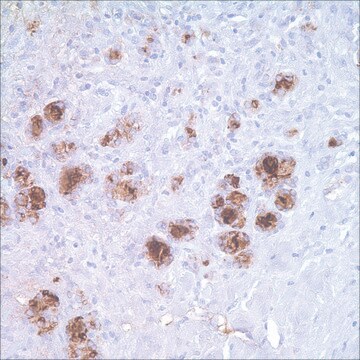It is advisable to start with the most conservative dilution to ensure optimal staining, with a starting dilution of 1:50
290M-1
MUC1 (MRQ-17) Mouse Monoclonal Antibody
Seleccione un Tamaño
152,00 €
Seleccione un Tamaño
About This Item
152,00 €
Productos recomendados
origen biológico
mouse
Nivel de calidad
100
500
conjugado
unconjugated
forma del anticuerpo
culture supernatant
tipo de anticuerpo
primary antibodies
clon
MRQ-17, monoclonal
descripción
For In Vitro Diagnostic Use in Select Regions (See Chart)
Formulario
buffered aqueous solution
reactividad de especies
human
envase
vial of 0.1 mL concentrate (290M-14)
vial of 0.5 mL concentrate (290M-15)
bottle of 1.0 mL predilute (290M-17)
vial of 1.0 mL concentrate (290M-16)
bottle of 7.0 mL predilute (290M-18)
fabricante / nombre comercial
Cell Marque®
técnicas
immunohistochemistry (formalin-fixed, paraffin-embedded sections): 1:50-1:200
isotipo
IgG1
control
breast
Condiciones de envío
wet ice
temp. de almacenamiento
2-8°C
visualización
cytoplasmic
Información sobre el gen
human ... MUC1(4582)
Descripción general
The heterogeneous pattern of mucin expression, including the expression of the intestinal mucin MUC2, may provide new insights into the differentiation pathways of gastric carcinoma. Pinto-de-Sousa et al. have shown in a comprehensive study of gastric carcinomas evaluated for expression of several mucins (MUC1, MUC2, MUC5AC and MUC6) that: (1) mucin expression is associated with tumor type (MUC5AC with diffuse and infiltrative carcinomas and MUC2 with mucinous carcinomas) but not with the clinico-biological behavior of the tumors; and (2) mucin expression is associated with tumor location (MUC5AC with antrum carcinomas and MUC2 with cardia carcinomas), indirectly reflecting differences in tumor differentiation according to tumor location.
The following generalities apply to the patterns of Mucin expression:
MUC1 expression: apical surfaces of most epithelial cells in breast, GI, respiratory, and GU tracts.
Associated products: MUC2, MUC5AC, MUC6, TAG-72, MOC-31, CEA
Calidad
 IVD |  IVD |  IVD |  RUO |
Ligadura / enlace
Forma física
Nota de preparación
Otras notas
Información legal
¿No encuentra el producto adecuado?
Pruebe nuestro Herramienta de selección de productos.
Elija entre una de las versiones más recientes:
Certificados de análisis (COA)
¿No ve la versión correcta?
Si necesita una versión concreta, puede buscar un certificado específico por el número de lote.
¿Ya tiene este producto?
Encuentre la documentación para los productos que ha comprado recientemente en la Biblioteca de documentos.
-
What is the recommended dilution rate for the IHC experiment using product MUC 1?
1 respuesta-
¿Le ha resultado útil?
-
Filtros activos
Nuestro equipo de científicos tiene experiencia en todas las áreas de investigación: Ciencias de la vida, Ciencia de los materiales, Síntesis química, Cromatografía, Analítica y muchas otras.
Póngase en contacto con el Servicio técnico








